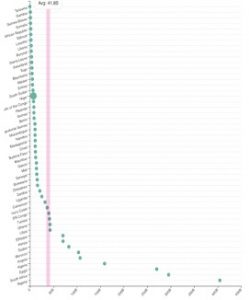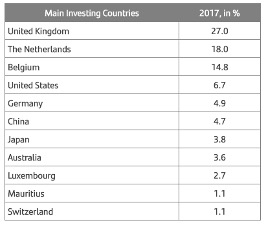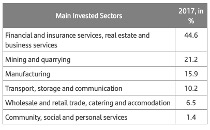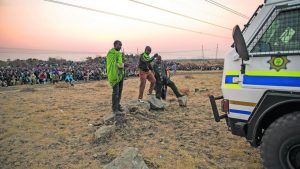
Based upon a report published by a World Population Review, South Africa is the second richest country in the continent of Africa (World Population Review 2020). Although it does not belong to the most developed country in the rankings, arguably it does not even rank in the top 10 based upon the Human Development Index, the country receives an astonishing amount of Foreign Direct Investment (hereafter FDI). South Africa’s Gross Domestic Product per capita in 2020 was estimated to be around 295.44 billion USD (World Population Review 2020). The only country topping this is Nigeria, who tops the charts with 404.65 billion USD GDP per capita. Santander published a report about FDI in figures concerned with South Africa. Yet, it is relatively unknown whether this FDI, which one would assume would be directly to South African companies, trickles back down into South African society. Can one see a correlation between FDI, high GDP, yet low HDI? Can we glance beyond the statistics?
Graphs, figures, and numbers
The 2020 Santander report suggests that South Africa’s economy is relatively attractive for foreign investment. The World Bank’s 2020 report ranked the country on the 84th place out of 190 economic systems (Satander 2020). The figures in the report show several interesting aspects. The primary figure is FDI inward flows from 2017 till 2019 (see figure 1).

As we can tell from the graph above, South Africa’s FDI has risen from 2017 to 2018 and stagnated slightly from 2018 to 2019. However, other numbers, such as the amounts of Greenfield Investments[1], have risen in the respective years. This suggests positive growth in the sense that it creates opportunities for South African locals.

The countries which tend to invest in South Africa’s economy are largely based in Europe. The main investor in 2017 was the United Kingdom, followed by the Netherlands (figure 2). The sectors in which these countries invested are diverse. The primary one is related to financial investment. The second largest one is related to mining and quarrying. This second one might need some more investigation beyond what is shown in these figures.

Marikana: Misreading the numbers?
Let me take you back to 2012. This was a turbulent year on a global level. The economy started to take off after the devastating world economic crisis of 2008. South Africa’s economy had already grown with 2.5 percent, whilst being 3.5 percent down the year before (Brand South Africa 2013). Although the mining sector still took up a large portion of the economy, however, it was not preforming at the rate it should have been at. Many news articles, statistics, and figures do not mention the reason behind the stagnating numbers of the mining industry.

In 2012, South Africa’s mining industry was largely dominated by Lonmin. Lonmin was a British producer of metals, among which platinum. One of their headquarters were located in Marikana, a small mining town near Johannesburg. On august 10th 2012, mining workers employed by Lonmin marched towards the main buildings of the company to demand higher pay. The payments which they received were too low to sustain themselves, let alone their families. These mining workers were forced to work under the most brutal circumstances and live in small cottages located near the mines. The demand for higher pay ended up in a protest which lasted until the 16th of august. During this 6-day period, a total of 34 mineworkers were killed by police brutality (Davies 2015). In the first published report about the mass murder, the numbers of the fallen mineworkers were disputed. Only upon a second investigation was the total confirmed.
After Marikana had caused an explosion of strikes and protests around the country, the South African government decided to appoint a commission to investigate what had exactly happened hand how the police had reacted in a disproportionate matter. Interestingly, before this commission was appointed, President Zuma, alongside other officials had gained immunity to have to appear in front of this commission. Moreover, President Zuma had been in charge of appointing the officials who were leading figures inside of the Lonmin company. Even more interesting, much of the revenue earned by the British owned company was never redistributed towards the lowest paid employees. It remained circling around the highest earning officials, arguably to remain in some sort of control. However, it is questionable how this horrific event has changed realities in South African mining industry.
Past, present, future?
I utilized the Marikana case study to gain a closer look into whether numbers really reflect the reality on the ground. Today’s numbers, which I illustrated in the beginning, show that South Africa still benefits from a high number of FDI. This mainly from European countries, such as the United Kingdom. As shown in the case of the Marikana Massacre, the FDI which is invested from countries and businesses outside of the country, do not benefit the ones which work to their deaths on the ground. Financially it circulates among the highest bidder. Although the statistics look promising, can we reassure that the ones who need actually get it. Can we make sure that we do not repeat such a disaster in the future? Can looking beyond statistics aid in this process?
[1] A Greenfield Investment is when the original company starts a new enterprise in the country where the direct investment is invested in. This is done through a construction from scratch, employing local manufacturers, employees, etc.
Sources:
Brand South Africa. “South Africa Posts 2.5% growth in 2012.” Published 26 Febuary 2013. https://www.brandsouthafrica.com/investments-immigration/business/economy/gdp-260213
Davies, Nick. “Marikana Massacre: The Untold Story of the Strike Leader who Died for Workers’ Rights.” The Guardian. Published Tuesday 19 May, 2015. https://www.theguardian.com/world/2015/may/19/marikana-massacre-untold-story-strike-leader-died-workers-rights
Satander. “South Africa: Foreign Investment.” Accessed October 12, 2020. https://santandertrade.com/en/portal/establish-overseas/south-africa/foreign-investment?url_de_la_page=%2Fen%2Fportal%2Festablish-overseas%2Fsouth-africa%2Fforeign-investment&&actualiser_id_banque=oui&id_banque=0&memoriser_choix=memoriser
World Population Review. “Richest African Countries 2020.” Accessed October 12, 2020. https://worldpopulationreview.com/country-rankings/richest-african-countries



Mirjam de Bruijn
October 14, 2020 (17:48)
Looking behind statistics is very important; it also means that statistics should make us question what is behind. It cannot be denied that statistics as in this case around economy show a certain ‘improvement’ but then indeed what do they do with inequality, who benefits. This is a very important question that also those who develop the statistics should take into account.